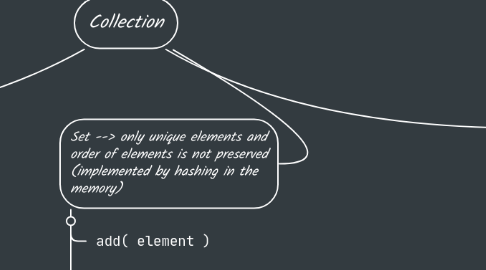
1. List
1.1. ArrayList- for each time the element added exceeds the size, ArrayList increases size as n+n/2 +1
1.1.1. add( element )
1.1.2. add( index , element )
1.1.3. get( index )
1.1.4. remove( index )
1.1.4.1. remove( type eg. Integer.valueOf(30) jis type ka arraylist us type ke element ki value)
1.1.5. addAll( list )
1.1.6. clear()
1.1.7. set( index , value )
1.1.8. contains
1.2. LinkedList
1.3. Stack
1.3.1. push()
1.3.2. peek() --> to get the value of topmost element in the stack
1.3.3. pop() --> removes the topmost element from stack
1.4. Vector
2. Circle
2.1. Interface
3. Rectangle
3.1. Class
4. Set --> only unique elements and order of elements is not preserved (implemented by hashing in the memory)
4.1. add( element )
4.2. remove( element )
4.3. contains( element )
4.4. isEmpty()
4.5. size()
4.6. clear()
4.7. EnumSet
4.8. HashSet
4.9. LinkedHashSet --> preserves the order of elements as well along with including properties of a set
4.10. TreeSet --> behind the scene the elements are sorted by using binary search tree
5. Iterator- type should be the same as that of the collection it is iterating. eg. Iterator<Integer> it= list.iterator(); Other commands include- it.hasNext() and it.next();
5.1. **ListIterator**
6. Queue
6.1. ArrayQueue
6.1.1. offer() --> adds element to the queue if operation is successful it returns TRUE else FALSE
6.1.2. poll() --> removes the element added in the beginning from the queue; returns NULL if queue is empty
6.1.3. remove() --> throws an exception if queue is empty
6.1.4. add() --> throws an exception if the element is not added successfully else returns TRUE
6.1.5. element() --> returns the head of the queue and throws an exception if the queue is empty
6.1.6. peek() --> tells us the element next in line to be removed (head of the queue and returns NULL if queue is empty
6.2. PriorityQueue --> is a type of queue in which we give priority to certain elements (by default ascending order i.e. minHeap implementation)
6.2.1. use Comparator.reverseOrder() to reverse the order
6.3. LinkedList
6.4. **Dqueue**
6.4.1. offerFirst() --> add in beginning
6.4.2. offerLast() --> add at last
6.4.3. pollFirst() or poll ()--> removes head
6.4.4. pollLast() --> removes the last element of dqueue
